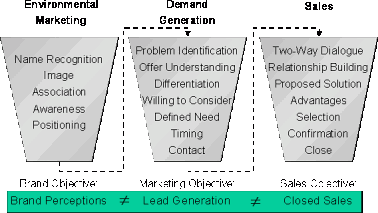As much as marketing has advanced its scientific approach to measuring and managing effectiveness, it is still much like a cross-country truck route that runs on a combination of superhighways and unpaved terrain.
The roadblocks and endless detours on the path to profitability are not the result of subtle errors in the execution of sophisticated techniques—they are mostly the result of not getting the fundamentals right.
In managing the customer journey, both Marketing and Sales are structured, motivated and measured in such a way that allows significant profits to be “leaking” along the way. Bringing together the customer perspective, alignment of the goals and metrics across customer touchpoints, and insight into optimizing profitability can guide strategies that can more effectively plug those leaks.
Core Problems
Let's start by reviewing some of the core problems inhibiting marketers' abilities to effectively manage profitability; we'll then run through several checkpoints for each to let you assess how your company is currently performing:
- Traditional marketing metrics and measurements are not designed to accurately capture ROI.
- The relationship between Marketing and Sales is disconnected.
- The sales cycle is not aligned with the buyers' perspective.
- The typical marketing and sales model built on feeding high volumes into the sales funnel to generate small conversion percentages misses opportunities.
- Key profitability drivers are not fully understood.
This four-part series of articles integrates key concepts from Hugh Macfarlane's recently published book, The Leaky Funnel: Earn more customers by aligning Sales & Marketing to the way businesses buy (Bookman Publishing, 2004), and Jim Lenskold's book, Marketing ROI: The Path to Campaign, Customer and Corporate Profitability (McGraw-Hill, 2003). Our objective is to outline our approach to improving your marketing ROI through better management of the integrated marketing and sales cycle.
The journey we will take you through will be presented in four articles that cover (1) a high-level self-assessment to determine potential sources of profit leakage; (2) how to map out and improve strategies around the buying cycle; (3) how to apply marketing ROI principles to create strategies to reduce and recycle leakage from the buying cycle; and (4) how to leverage insight on your key profit drivers and customer-level analysis to improve profitability.
This first article takes you through a self-guided assessment to prepare you for the steps that follow in the next three articles. As you go through each list of checkpoints, note those points where you answer “no.” These are indicators of potential profit leakage that require a closer look in the context of this article series.
Traditional Metrics Versus Marketing ROI
Objectives are set to motivate and measure employee performance. Many of the traditional marketing metrics were originally established based on what could be measured and are not necessarily reflective of the true corporate objectives. Marketing metrics that are based on the completion of activities are intended to align with profitability but leave significant room to guide the wrong decisions and behaviors.
Greater discipline, backed up by improvements in data accessibility, technology, and advanced practices, provide new opportunities to bring your marketing analysis and measurements to a new level.
Checkpoint No. 1
- Do you use metrics such as lead generation, cost per lead, awareness, purchase intention, Web visits, permission subscriptions, call center contacts or store visits as performance indicators to guide decisions—but use ROI (or a close equivalent) as the ultimate objective?
- Is your marketing effectiveness driven by the close rate and incremental profits generated at the completion of the sales cycle, regardless of whether the closed sales come from your sales team, marketing channels and/or sales channel partners?
- Do your metrics reflect improvements in incremental customer value that come from generating larger sales, more frequent repeat purchasing, higher customer retention rates, lower costs to serve customers and a more profitable product/service mix?
Traditional metrics are still necessary to quickly assess our performance, but we also need to integrate with a more complete marketing ROI process in place to project and validate the actual financial impact of our marketing. Without marketing ROI, marketers can easily be wasting portions of their budget and missing opportunities to drive incremental customer value.
Marketing and Sales Disconnect
For marketing to be profitable, it is imperative that the process be measured and managed completely through the sales cycle. Many B2B and some B2C companies that have a sales force are structured so that Marketing's role ends with the handoff of leads. Many B2C and some B2B companies have a handoff to retailers, independent agents or other third party intermediaries that are responsible for the final sale to the end customer.
Companies in which marketers sell directly to the customer have a distinct advantage in managing the entire process. When two or more organizations or companies are involved in moving customers through each stage of the sales cycle, very often their objectives and metrics are not fully aligned.
Checkpoint No. 2
- Are your communications starting with initial brand awareness and extending through to a completed sale managed as a fully integrated processes in a cohesive sales cycle?
- Are your marketing objectives established based on the financial contribution from targeted customers such as acquisition of new customers, incremental retained and saved profits, growth in customer spend and win-back contribution?
- Do you use an analysis of the Sales pipeline (from lead to close) to guide future marketing strategies?
- Do you understand what drives conversion rates within the Sales pipeline?

From a corporate perspective, both marketing and sales objectives should be aligned around profitably generating business growth from existing and new customers. Too often Marketing is not pleased with the Sales follow-up efforts and Sales is not pleased with the quality of leads generated by Marketing.
When Sales is not converting the leads generated by Marketing, investments are wasted and profits are gushing out of the funnel. The same applies when the team responsible for branding creates awareness and interest that is not converted into action by the various customer touchpoints in Sales and Marketing. These organizations must work together to maximize the right leads that will continue through all successive stages in the buying cycle.
Alignment Between the Sales Cycle and the Buying Cycle
Looking at the relationship from the buyers' perspective provides a much clearer view of where that individual (or customer segment) is in our sales cycle and also what marketing and sales initiatives can be most effective.
For example, some of our marketing efforts will reach prospects before they have identified a need or problem, in which case our branding efforts can have some impact but a sales call cannot.
Shifting to a buyers' mindset is extremely beneficial in defining the purpose of each marketing initiative in effectively moving the right customers through the sales cycle.
Checkpoint No. 3
- Do you know what the buying cycle looks like—from acknowledging a need to completion of the purchase?
- Do you know what each marketing and sales initiative contributes to move different prospects into each successive stage of the buying cycle?
- Have you mapped your integrated marketing and sales cycle to the buying cycle?
- Do you understand why prospects do not move to the next stage in the sales cycle?
The second article in this series will present the buying cycle.
Playing the Volume Game
Converting even fractions of a percent of your contacts into closed sales is often enough to be considered a huge success. As long as there are enough prospects, the formula is quite simple: condition, market, sell, repeat.
Even if those campaigns are profitable, money is wasted on prospects that will never buy, and profits are lost when prospects move in the sales cycle and then slip back to the starting point. Strategically, you also need to consider how prospect perceptions evolve over time with each repeated contact that does not result in closed sales.
Checkpoint No. 4
- Do you know how many contacts early in your sales cycle are required to generate your target closed-sales objectives?
- Have you tracked the lag time between each stage in the buying cycle (and/or the sales cycle) to effectively manage your sales objectives and identify gaps far in advance of the sales shortfall?
- Have you analyzed customer value and conversion rates to identify which customer segments flow through the funnel profitably and which are a wasted expense?
- Have you analyzed profitability at the prospect/customer level to know when your prospecting investments exceed the potential returns?
The third and fourth articles will present you with an innovative and thought-provoking view of how you can better manage the integrated marketing and sales funnel.
Identifying Key Profit Drivers
Marketers must understand the key profit drivers within each marketing program or campaign so that decisions on improving effectiveness and efficiency can be directed where the greatest ROI exists.
Checkpoint No. 5
- In the process of mapping out the sales/buying cycle, tracking the conversion rates throughout the cycle and understanding customer value for each segment, can you identify the key profit drivers that must be managed to optimize marketing profitability?
- Do you know your strengths and weaknesses in moving prospects and customers through the marketing and sales cycle?
- Do you know where in the cycle investments to improve your marketing effectiveness can have the greatest ROI?
- Can you identify where marketing investments are excessive or are wasted because of bottlenecks and barriers later in the cycle?
The path guided by a combination of the marketing ROI process and the sales funnel process can streamline your journey to better management of your marketing profitability. The goal is to leverage the insight gained from each to modify existing and create new strategies and tactical plans.
The remaining three articles in this Marketing ROI series will guide you with specific steps and a framework for uncovering the profit potential that come from both the obvious and the hidden leaks in the funnel.




